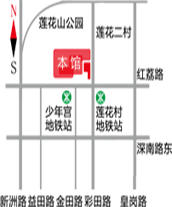
- 50 Years of Kaikai - Exhibition of Art Research Documents in Qijiadawa
-

Click to view Exhibition period: December 4th to December 10th, 2014
Exhibition opening time: 10:00 am on December 4th, 2014
Academic seminar: December 4th, 2014, from 2:30 pm to 6:00 pm
Exhibition Venue: Central Hall and C Hall of Shenzhen Guanshan Moon Art Museum
Seminar location: Academic Lecture Hall on the Third Floor of Guanshan Yue Art Museum
Hosted by: China Artists Association, Shenzhen Municipal Bureau of Culture, Sports and Tourism
Undertaking unit: Shenzhen Guanshanyue Art Museum
1、 The Gadawa Art Exhibition and the Guan Shan Yue Art Museum's "20th Century Chinese Art Research"
After nearly two years of careful planning, the "50 Years of Open Road - Its Gadawa Art Research Literature Exhibition" will be exhibited at the Guanshan Yue Art Museum from December 4th to December 10th, 2014. This exhibition is jointly organized by Chinese artists, the China Association for the Promotion of Ethnic Minority Culture and Art, and the Shenzhen Municipal Bureau of Culture, Sports, and Tourism, and hosted by the Shenzhen Guanshan Yue Art Museum. It is an important academic activity launched by the Guanshan Yue Art Museum in 2014.
The collection, research, and exhibition of Chinese art works and related literature in the 20th century is one of the main academic directions of the Guan Shan Yue Art Museum, and it is also an important historical mission undertaken by the Guan Shan Yue Art Museum. Focusing on academic positioning, our museum has further deepened our academic thinking on the research topic of "20th century Chinese art research", especially on 20th century Chinese printmaking, by continuously planning and launching a series of special exhibitions and studies on 20th century Chinese art masters. The collection, research, and exhibition of printmaking is one of the distinctive academic directions of the Guan Shan Yue Art Museum. Targeting the group of old printmakers, the Guan Shan Yue Art Museum uses a case study approach, through literature review and research, to restore them to the social and cultural environment of the time, and deeply explore the artistic and social value of their works from the perspective of printmaking art development history.Qijiadawa, a Tibetan, was born in Ganzi, Sichuan in 1946. His parents passed away during his childhood and he became an orphan. Fortunately, he was adopted by the people's government and went to primary school. In 1959, he was recommended to study in the Ethnic Class of Sichuan Academy of Fine Arts. After graduating in 1964, he was assigned to the Sichuan Branch of the China Artists Association to engage in printmaking creation. He has served as the Secretary General and Executive Vice Chairman of the Sichuan Artists Association, Deputy Director of the Sichuan Art Museum, Director of the China Artists Association, and Member of the Printmaking Art Committee of the China Artists Association, enjoying special government allowances from the State Council. In 1999, he was transferred to the position of Executive Vice President of Shenzhen Painting Academy and concurrently served as a member of the Printmaking Art Committee of Guangdong Artists Association, a member of the Shenzhen Political Consultative Conference, and the Deputy Director of the Art Review Committee of the Shenzhen Special Fund for the Development of Propaganda and Culture. His arrival greatly promoted the development of Shenzhen's printmaking industry. Qijiadawa has been engaged in artistic creation for 50 years, and his works have participated in major exhibitions both domestically and internationally and won several awards. Many of his representative works, such as "The Open Road," "The Woodcutter," and "The Golden Autumn," have become iconic and important works in the development of modern printmaking in China. Among them, "The Woodcutter," won the "Gold Award" from the Japan China Art Research Association at the Ten
Based on the above reasons, Mr. Gadava's art has entered our field of vision. Organizing, collecting, and researching his works and artistic experiences is currently an urgent and meaningful task for our library. Therefore, we plan to systematically collect more than 60 representative works of Mr. Gadava's printmaking, as well as a batch of creative sketches and literature materials. This exhibition adopts a case study approach, through literature review and research, to deeply explore the artistic and social value of its works from the perspective of the development history of printmaking art, in order to improve the printmaking part of our museum's "20th Century Chinese Art Research and Literature Library Construction".
2、 The academic positioning of his Gadava art research:
(1) Qijiadawa is an important representative of the generation of printmakers in China who have inherited the past and opened up the future. His contributions to the development of Chinese printmaking have been multifaceted. After the founding of the People's Republic of China, especially after the reform and opening up, Chinese printmaking has faced multi-dimensional development and transformation. As a representative of the generation of printmakers who mainly grew up after the founding of the People's Republic of China, his artistic process and ideas to a certain extent reflect the overall trend of Chinese printmaking in this historical period, and overall have typical significance.
(2) As an older generation artist from the Tibetan region who has personal experience of the peaceful liberation of Xizang and the construction of new Chinese art, his Gadava is like a living fossil of studying the social situation at that time and the development of new Chinese art in the context of the era from the sociological perspective. The in-depth study of his art history is of great significance to the promotion of the overall subject of Chinese art research in the 20th century.
(3) Since the new era, the development of contemporary art, composed of art movements and events, has also changed the way art history is written. Art movements, trends, and events have replaced individual artists as the main body of art history writing. He has served as the main person in charge of the Sichuan Artists Association, Printmakers Association, and Shenzhen Painting Academy. He has invested a lot of energy in the organization and leadership of various printmaking activities since the new era, especially making important contributions to the development of the Sichuan printmaking school.
(4) Qijiadawa is one of the important representative painters of black and white woodblock prints in China. He placed his emotions, evaluations, and criticisms of society in the portrayal of character images, promoting the maturity of black and white woodblock prints in the Sichuan printmaking school.
(5) Since the reform and opening up, there has been a group of old artists in Shenzhen who have made outstanding contributions to the art industry. They are promoting the development of Shenzhen's art culture and cause with a spirit of dedication and noble artistic character. Through the accumulation and collection of case studies on the older generation of artists in Shenzhen, and touching on the development of art in Shenzhen for over 30 years through the artist's artistic journey, we will organize exhibitions and literature collections with research value. This not only plays a positive role in the development of art research in Shenzhen, but also plays a positive role in promoting the establishment of academic research in Shenzhen's art throughout the country.
3、 Summarize the achievements of Gadava art and the development process of modern Chinese printmaking through exhibitions, academic seminars, and other series of activities
In addition to the "50 Years of Open Road - Exhibition of Gadawa Art Research Literature", in order to deeply summarize Mr. Gadawa's artistic achievements and contributions to the development of Chinese printmaking, the Guan Shan Yue Art Museum will also hold an academic seminar on "The Field of Art and Artists' Social Practice - Exhibition of Gadawa Art Research Literature" during the exhibition period. Taking the development of New China's society and the development of fine arts as a reference frame, through a case analysis of his Gadawa art, especially printmaking art, the transformation history of Chinese printmaking after the founding of the People's Republic of China and its enlightening significance for the transformation and transformation of contemporary printmaking art from the perspective of printmaking art ontology development will be summarized. At that time, 20 theorists, critics, and printmakers from all over the country will participate in this seminar. After the exhibition and academic seminar, the Guan Shan Yue Art Museum will also gather the results of the exhibition and seminar, and the Sichuan Fine Arts Publishing House will publish and distribute the "50 Years of Open Road - Collection of Research Documents on Gadawa Art".
In 2014, it was the 50th anniversary of his Gadava debut work "The Road" and also his 50th anniversary in the entertainment industry. The Guan Shan Yue Art Museum has placed Mr. Gadava's artistic journey into the overall framework of 20th century Chinese art research through case studies of him, as well as a series of exhibitions, academic discussions, and academic publications launched through this. Through the organization, compilation, and presentation of his artistic experience and related literature, on the one hand, it conducts academic sorting of his artistic journey, and on the other hand, through the case studies of him and other contemporary art masters, it presents the development process of modern Chinese art from different perspectives.
-
2014-12-02



